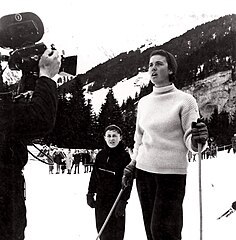Yvonne Rüegg
 | ||||||||||||||||
| Data i miejsce urodzenia | ||||||||||||||||
|---|---|---|---|---|---|---|---|---|---|---|---|---|---|---|---|---|
| Klub | SC Arosa | |||||||||||||||
| Dorobek medalowy | ||||||||||||||||
| ||||||||||||||||
Yvonne Siorpaes z d Rüegg (ur. 2 sierpnia 1938 w Chur) – szwajcarska narciarka alpejska, mistrzyni olimpijska i mistrzyni świata.
Kariera
Największy sukces w karierze Yvonne Rüegg osiągnęła w 1960 roku, kiedy podczas igrzysk olimpijskich w Squaw Valley zwyciężyła w slalomie gigancie. W zawodach tych o 0,1 sekundy pokonała Penny Pitou z USA, a o 0,3 sekundy wyprzedziła Włoszkę Giulianę Minuzzo. Był to pierwszy w historii złoty medal dla Szwajcarii wywalczony w tej konkurencji w rywalizacji kobiet. Na tych samych igrzyskach Rüegg była także dziewiąta w zjeździe, a rywalizacji w slalomie nie ukończyła, wypadając z trasy w pierwszym przejeździe. Były to jej jedyne starty olimpijskie. W tym samym roku była też trzecia w gigancie na zawodach SDS-Rennen w Grindelwald. W 1959 roku została mistrzynią Szwajcarii w zjeździe. W 1964 roku zakończyła karierę.
Wyszła za mąż za włoskiego alpejczyka, Roberto Siorpaesa i od 1963 roku reprezentowała Włochy. Jest szwagierką byłych bobsleistów Gildo i Sergio Siorpaesów oraz teściową curlerki Violetty Caldart.
Osiągnięcia
Igrzyska olimpijskie
| Miejsce | Dzień | Rok | Miejscowość | Konkurencja | Czas biegu | Strata | Zwyciężczyni |
|---|---|---|---|---|---|---|---|
| 9. | 20 lutego | 1960 | Zjazd | 1:37,6 min | +4,0 s | ||
| 1. | 23 lutego | 1960 | Gigant | 1:39,9 min | - | - | |
| DNF1 | 26 lutego | 1960 | Slalom | 1:49,6 min | - |
Mistrzostwa świata
| Miejsce | Dzień | Rok | Miejscowość | Konkurencja | Czas biegu | Strata | Zwyciężczyni |
|---|---|---|---|---|---|---|---|
| 9. | 20 lutego | 1960 | Zjazd | 1:37,6 min | +4,0 s | ||
| 1. | 23 lutego | 1960 | Gigant | 1:39,9 min | - | - | |
| DNF1 | 26 lutego | 1960 | Slalom | 1:49,6 min | - |
Bibliografia
- Profil na stronie FIS (niem. • ang. • fr.)
- Profil na Sports Reference.com. sports-reference.com. [zarchiwizowane z tego adresu (2010-01-30)]. (ang.)
Media użyte na tej stronie
Olympic Rings without "rims" (gaps between the rings), As used, eg. in the logos of the 2008 and 2016 Olympics. The colour scheme applied here pertains to the 2016 Olympics in Rio de Janeiro.
Olympic Rings without "rims" (gaps between the rings), As used, eg. in the logos of the 2008 and 2016 Olympics. The colour scheme applied here pertains to the 2016 Olympics in Rio de Janeiro.
The flag of Navassa Island is simply the United States flag. It does not have a "local" flag or "unofficial" flag; it is an uninhabited island. The version with a profile view was based on Flags of the World and as a fictional design has no status warranting a place on any Wiki. It was made up by a random person with no connection to the island, it has never flown on the island, and it has never received any sort of recognition or validation by any authority. The person quoted on that page has no authority to bestow a flag, "unofficial" or otherwise, on the island.
Flag of the unified Team of Germany for the Olympic Games, 1960–1968.
Autor: B1mbo, Licencja: CC BY-SA 2.5
Drawing of a gold medal, based on Olympic rings.svg.
The Canadian Red Ensign, the national flag of Canada from 1957 to 1965. (see: the Canadian Red Ensign on the Register of Arms, Flags and Badges)
Pictograms of Olympic sports - Alpine skiing
Autor: Renehaas, Licencja: CC BY-SA 4.0
Yvonne Rüegg







